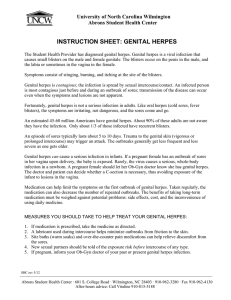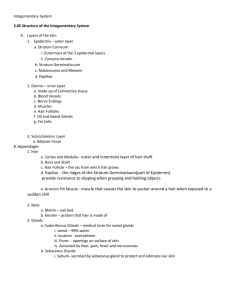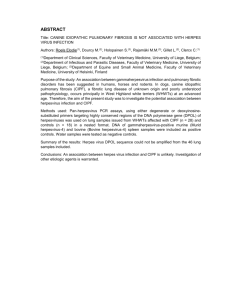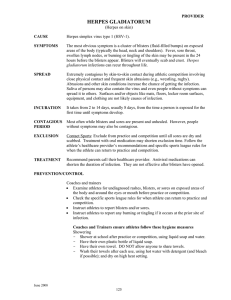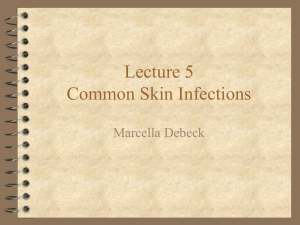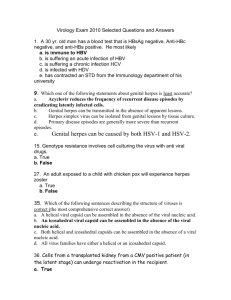Skin Conditions Outline
advertisement
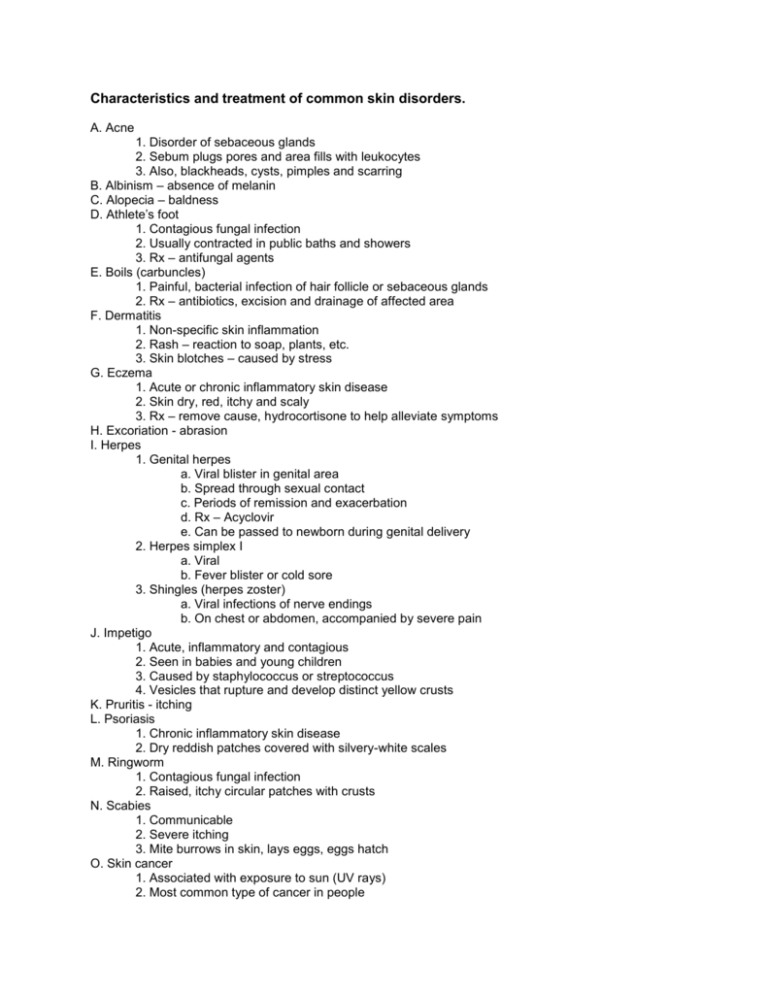
Characteristics and treatment of common skin disorders. A. Acne 1. Disorder of sebaceous glands 2. Sebum plugs pores and area fills with leukocytes 3. Also, blackheads, cysts, pimples and scarring B. Albinism – absence of melanin C. Alopecia – baldness D. Athlete’s foot 1. Contagious fungal infection 2. Usually contracted in public baths and showers 3. Rx – antifungal agents E. Boils (carbuncles) 1. Painful, bacterial infection of hair follicle or sebaceous glands 2. Rx – antibiotics, excision and drainage of affected area F. Dermatitis 1. Non-specific skin inflammation 2. Rash – reaction to soap, plants, etc. 3. Skin blotches – caused by stress G. Eczema 1. Acute or chronic inflammatory skin disease 2. Skin dry, red, itchy and scaly 3. Rx – remove cause, hydrocortisone to help alleviate symptoms H. Excoriation - abrasion I. Herpes 1. Genital herpes a. Viral blister in genital area b. Spread through sexual contact c. Periods of remission and exacerbation d. Rx – Acyclovir e. Can be passed to newborn during genital delivery 2. Herpes simplex I a. Viral b. Fever blister or cold sore 3. Shingles (herpes zoster) a. Viral infections of nerve endings b. On chest or abdomen, accompanied by severe pain J. Impetigo 1. Acute, inflammatory and contagious 2. Seen in babies and young children 3. Caused by staphylococcus or streptococcus 4. Vesicles that rupture and develop distinct yellow crusts K. Pruritis - itching L. Psoriasis 1. Chronic inflammatory skin disease 2. Dry reddish patches covered with silvery-white scales M. Ringworm 1. Contagious fungal infection 2. Raised, itchy circular patches with crusts N. Scabies 1. Communicable 2. Severe itching 3. Mite burrows in skin, lays eggs, eggs hatch O. Skin cancer 1. Associated with exposure to sun (UV rays) 2. Most common type of cancer in people 3. Basal cell carcinoma a. Most common, least malignant b. Usually on face c. Rx – surgical removal or radiation 4. Squamous cell carcinoma a. Mostly scalp and lower lip b. Grows rapidly, metastasizes to lymph nodes c. Rx – surgical removal or radiation d. Prognosis good with early diagnosis 5. Melanoma a. Malignant b. Occurs in melanocytes c. Metastasizes to other areas quickly d. Brown or black irregular patch that occurs suddenly e. Change in existing wart or mole may indicate melanoma f. Rx – surgical removal of melanoma and surrounding area and chemotherapy P. Burns 1. First degree a. Superficial, skin red and dry b. Involves only epidermis c. Rx – cold water d. Heals in one week 2. Second degree a. Epidermis and dermis b. Pain, swelling, redness and blistering c. Subject to infection d. Rx – pain medication, dry sterile dressing e. Healing within two weeks 3. Third degree a. Epidermis, dermis, and subcutaneous layers (full thickness) b. Loss of skin, blackened skin c. May be life threatening d. Rx – prevention of infection, fluid replacement, skin grafting


